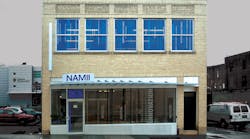Along a certain stretch of downtown Youngstown, Ohio, amid the forgotten factories and shuttered storefronts of the long-struggling, post-industrial city, workers are busy restoring and refurbishing the remnants of a century-old furniture warehouse.
See Also: Manufacturing Industry Technology News & Trends
In that squarish, nondescript space, crews are tearing out the rotted wood and obsolete equipment piled up since the dawn of the 20th century and replacing it with some very 21st century gear—Stratasys FDM rapid prototyping units, ExOne metal-based additive manufacturing machines, Renishaw and Z-Corp printers, even a mammoth sPro selective laser sintering system from 3D Systems. They are transforming the relic into a shining, fully equipped innovation center that would fit in next to any slick Silicon Valley tech hub.
And for good reason. This is the home of the National Additive Manufacturing Innovation Institute (NAMII)—a place where all the eyes of the industrial nation have turned in anxious anticipation.
It's where the future of American manufacturing will soon be decided.
"No Problem"
Just two months into the job, NAMII Director Ed Morris bears the weight of that pressure with ease.
"Our only job here is to help reenergize manufacturing in the United States," he laughs. "No problem."
NAMII, created in August 2012, is the first of what could eventually be 16 advanced manufacturing hubs designed to bring together industry, academia and government to help accelerate innovation and advance emerging manufacturing technologies.
This proof-of-concept model for future National Network for Manufacturing Innovation (NNMI) centers—loaded up with $30 million of government funds and another $39 million from private partner investments—is assigned the task of bringing together the best minds of the industry in the name of 3-D printing.
See Also: 3-D Printing on Display at NAMII [SLIDESHOW]
"Our objective is to advance the craft of advanced manufacturing, to knock down the existing barriers for a ubiquitous use of additive manufacturing—not only for the current investors, but for the U.S. industry at large," Morris explains.
"It's a daunting task," he says. "But bottom line, I see us having a powerful impact on American manufacturing."
His calm confidence about that is impressive given the pressure he is under to start making the center a profitable enterprise. Fast. Especially in light of the attention he has received after President Obama told the world about the "once shuttered warehouse" turned "state-of-the-art lab" in his State of the Union address.
In that speech, the President used NAMII's early progress and promise of success as the basis for a call for the federal funds necessary to create the next 15 hubs, putting Morris and whatever he is able to accomplish in the next few months on the line for not only the future of additive manufacturing, but the future of all advanced technologies funding in the country.
And that's before the full staff has even started. A daunting task indeed.
The Elephant in the Room
At the end of March, just shy of its seven-month anniversary, NAMII announced the recipients of its first round of funding—$4.5 million for seven teams of universities and manufacturers that will soon be working hand-in-hand to develop new tools, new uses and new understanding of 3-D printing processes.
One of these winning projects, awarded to Cleveland's Case Western Reserve University, highlights all of the qualities NAMII projects are supposed to exhibit.
The project links together the minds and assets of Case Western Reserve and Pittsburgh's Carnegie Mellon University as well as manufacturing giants Pratt & Whitney (IW 500/24), GE Aviation (IW 500/5) and Lockheed Martin (IW 500/30), among others—all competitors on the traditional market—in order to develop a way to qualify 3-D printed parts for aerospace, medical and other highly-regulated fields.
The potential gains of an open collaboration with such an all-star cast of industrial and academic leaders are significant. As is the potential financial gain of proving the utility of additive manufacturing for these markets.
And that point—the fact that the end result of this project will be a salable process any one of these entities involved could take to market—brings up an issue no one in the collective has had a chance to work out yet, one that could have disastrous ramifications for the whole initiative: intellectual property.
The IP Problem
On campus at Case, the question of IP was already creating a stir just hours after the announcement of its NAMII awards.
"The IP thing has already been an active issue of discussion," explains James McGuffin-Cawley, chair of the material science and engineering department at Case.
"We are trying to satisfy the needs of industry and the needs of the universities and the needs of the government in terms of IP," he says. "And they truly are needs. We have responsibilities to our students and to the goals of federal funding, and the companies all have to be conscientious that they are engaged in a sound business practice."
"It's really an area that has to be figured out," he stresses.
The fact that these organizations could have gotten this far, that they drafted a proposal together and are now connected, money-in-hand, to pursue the project without having it figured out speaks to the accelerated, high-stakes nature of NAMII.
"NAMII has had a series of aggressive timetables," McGuffin-Cawley says. The whole process was unusually compressed, he notes, announcing the call for proposals just four months after its launch and handing out the awards just three months after that. It was so compressed, he says, that there was simply no way to work out the details ahead of time.
"It was a lot of things being done in parallel," he explains. "We've just had to trust each other and focus on getting things up and running while still figuring them out."
This has created a potentially perilous situation as projects get underway across the country. If NAMII and its members—especially those involved in the inaugural projects—fail to work this out, it would demonstrate that the collaboration and neutral exchange of ideas that form the basis of NAMII don't work. In other words, as a proof-of-concept model, if NAMII can't prove this crucial piece of the puzzle, then the concept is a bust.
Voice of Concern
Dave Burns, COO of NAMII-member ExOne—a Pittsburgh-based additive manufacturer—sees IP as a problem fundamental to the collaborative environment, which could derail the projects long before they have a chance to find any marketable solutions.
"Eventually, in order to solve a problem, someone is going to have to bring to the fold something that they've got carefully protected and make it public domain," he warns. "I can't imagine having to look a shareholder in the eye and tell him that for the good of the country I brought into the public domain something we have spent millions of dollars developing."
Doing so, he says, would rely on a collaborative model that runs against the basic American business system—the "fierce, independent capitalism" that has traditionally kept R&D work as a private, guarded asset.
Bringing that to the table with other manufacturers and with universities is something that defies basic business sense in this country, he says. And failure to solve that issue—and solve it fast—could stop NAMII and the NMII in their tracks.
"In the end, the IP issue will be the most dominant and most pervasive question to be solved," he says. "It has not been figured out yet and that should be a concern for a lot of folks. We're certainly concerned about it."
For more on the National Additive Manufacturing Innovation Institute (NAMII), including slideshows and video, click here.





